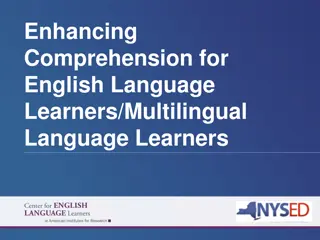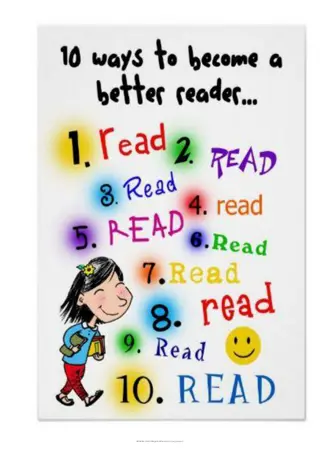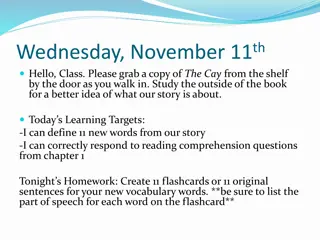Vocabulary Coverage and Reading Comprehension of University EFL Learners
University EFL learners' reading comprehension is closely linked to their vocabulary knowledge. A broad vocabulary positively impacts reading ability, with 98% vocabulary coverage facilitating successful reading without dictionary support. Indonesian high school graduates typically have a lower vocabulary size than necessary, affecting their reading proficiency. The study emphasizes the importance of vocabulary breadth for efficient reading comprehension among EFL students.
Download Presentation

Please find below an Image/Link to download the presentation.
The content on the website is provided AS IS for your information and personal use only. It may not be sold, licensed, or shared on other websites without obtaining consent from the author.If you encounter any issues during the download, it is possible that the publisher has removed the file from their server.
You are allowed to download the files provided on this website for personal or commercial use, subject to the condition that they are used lawfully. All files are the property of their respective owners.
The content on the website is provided AS IS for your information and personal use only. It may not be sold, licensed, or shared on other websites without obtaining consent from the author.
E N D
Presentation Transcript
Vocabulary Coverage and Reading Comprehension of University EFL Learners Presented by: Boniesta Melani Sudirman Willian Kurniawan Apgrianto Husnul Lail CONAPLIN The Thirteenth Conference on Applied Linguistics (CONAPLIN 13)
The knowledge of vocabulary has been shown to be positively associated with a second language (L2) learners' ability to read (Staehr, 2008). Word knowledge is crucial for reading comprehension and that a reader who knows only a few words tends to be a poor reader (Freebody & Anderson, 1983; Dixon et al., 1988; Nagy et al., 1987; Stahl et al., 1989). The breadth of vocabulary knowledge accounts for more than 60% of the variance in reading comprehension (Beglar & Hunt, 1999; Laufer, 1992; Moinzadeh & Moslehpour, 2012; Qian, 1999). Laufer (1989) discovered that learners with 95% or more familiarity of the words appeared in the reading texts can significantly facilitate the learners to adequately comprehend the text (scored 55% or higher on reading test). 3
98% coverage provides more opportunity for L2 readers to read without dictionary look-up. 95% can significantly facilitate L2 learners to be successful readers (scored 55% or higher on reading test). Less than 95% is recommended for intensive reading to develop language proficiency and the use of strategies (Nation, 2013). 4
The knowledge of vocabulary has been shown to be positively associated with a second language (L2) learners' ability to read (Staehr, 2008). Word knowledge is crucial for reading comprehension and that a reader who knows only a few words tends to be a poor reader (Freebody & Anderson, 1983; Dixon et al., 1988; Nagy et al., 1987; Stahl et al., 1989). The breadth of vocabulary knowledge accounts for more than 60% of the variance in reading comprehension (Beglar & Hunt, 1999; Laufer, 1992; Moinzadeh & Moslehpour, 2012; Qian, 1999). Laufer (1989) discovered that learners with 95% or more familiarity of the words appeared in the reading texts can significantly facilitate the learners to be successful readers (scored 55% or higher on reading test). Indonesian high school graduates are likely to have a lesser amount of vocabulary size than the number of words expected to be learned (Quin, 1968; Nation, 1974; Melani et al., 2013; Nurweni & Read, 1999). 5
Indonesian EFL Vocabulary Indonesian EFL s Vocabulary Size 6000 4000 4000 4000 4000 4000 1364 1226 1000 600 2000 University EFL students in Salatiga, Central Java, showed words mastery lesser than 1000 of the most frequent words on a translation test of the GSL (West, 1953) after six years of EFL instruction at high school (junior and senior high school) (Quinn, 1968). 0 Quinn (1968) Nation (1974) Nurweni & Read (1999) Melani et al., (2013) University freshmen in a university in Lampung reported a vocabulary size of approximately1226 words, which is far below the 4000 word standard set by the national curriculum (Nurweni & Read, 1999). Estimated vocabulary size National standard Indonesian EFL learners show a low English vocabulary mastery (Nation, 1974; Quin, 1968), which is below the National standard (Melani et al., 2013; Nurweni & Read, 1999). University starters were estimated to have vocabulary size roughly around 1364 words on receptive section of Vocabulary Levels Test (Schmitt et al., 2001) ) (Melani et al., 2013). According to the National curriculum, high school students are required to learn approximately 4000 words in senior high school; this includes 1500 words that should have been learned in junior high school (National Curriculum of 1974 and 1984). Indonesian university students recognized around 600 words appeared in reading passages. The students show unfamiliarity with basic vocabulary items such as pronouns, days of the week, numbers and high-frequently used verbs (Nation, 1974). EFL learners should have already learned around 4000 5000 English words when graduating high school. 6
The knowledge of vocabulary has been shown to be positively associated with a second language (L2) learners' ability to read (Staehr, 2008). Word knowledge is crucial for reading comprehension and that a reader who knows only a few words tends to be a poor reader (Freebody & Anderson, 1983; Dixon et al., 1988; Nagy et al., 1987; Stahl et al., 1989). The breadth of vocabulary knowledge accounts for more than 60% of the variance in reading comprehension (Beglar & Hunt, 1999; Laufer, 1992; Moinzadeh & Moslehpour, 2012; Qian, 1999). Laufer (1989) discovered that learners with 95% or more familiarity of the words appeared in the reading texts can significantly facilitate the learners to be successful readers (scored 55% or higher on reading test). Indonesian high school graduates are likely to have a lesser amount of vocabulary size than the number of words expected to be learned (Quin, 1968; Nation, 1974; Melani et al., 2013; Nurweni & Read, 1999). There is a need to estimate university EFL learners vocabulary coverage on the reading materials use to predict their reading comprehension ability. 7
Research questions 1. What is the fourth semester university EFL learners' vocabulary coverage on intensive reading materials designed for intermediate to advanced ESL learners? 2. How can the students cope with reading comprehension with their vocabulary coverage? 2
Methods 3
Data Collection The texts lexical diversity was cchecked using V_Words program. All subjects read al the texts. The subjects were asked to identify unfamiliar words in each text. The subjects were asked to translate the meaning of reported unfamiliar words. All unknown words identified were listed Frequency check were conducted to all unknown words. Analysis Calculating the % of known vocabulary in the texts (Laufer & Sim, 1985). Number of known words = Total words in text - (number of unknown words + number of misinformed words x (number of differences x 100) Reading Materials 6 texts of general topics (i.e., Money, Canning Food, Pottery, Bringing Up Children, Auction Sale, dan Social Classes) were randomly selected from those use in the beginning, in the middle, and at the end of the semester. All materials were taken from Practical Faster Reading: An Intermediate/Advanced Course in Reading and Vocabulary ( Mosback & Mosback, 1976). They are written for intermediate to advanced ESLs. Participants 4thsemester university EFL learners (N=50) Age: 19 to 25- year old. At least 7 years of EFL experience. https://www.lognostics.co.uk/tools/index.htm Instrument Types (different words) and tokens (running words) counts were conducted to check the texts' lexical diversity. Utilize the V_Words program (a small utility program that produces type and token counts for short texts (Meara & Miralpeix, 2016). https://www.lognostics. co.uk/tools/index.htm. Vocabulary Profile (Compleat Lextutor) https://www.lextutor.ca /vp/ checked the frequency of unfamiliar words. https://www.lognostics.co.uk/tools/index.htm https://www.lognostics.co.uk/tools/index.htm https://www.lextutor.ca/vp/ https://www.lextutor.ca/vp/ 10
Results 4
Vocabulary Coverage The texts are similar in length and level of difficulty. The learners know around 98% of the words used in the texts, meaning that they will find the materials easy to comprehend With 98% coverage, the readers can read independently without dictionary look-up. The possibility to vocabulary learning in incidental (unintentional) condition is high. The coverage provides less opportunities to develop language and strategic competencies. Texts Tokens Types Unfamili ar words 6.36 Coverag e 98.7% Money 476 244 Canning Food Pottery Bringing Up Children Auction Sale Social Classes 482 261 9.64 98% 511 470 262 241 8.12 6.8 98.4% 98.6% 516 502 275 269 8.73 11.51 98.3% 97.7% 12
Most of the unfamiliar words are nouns Unfamiliar words Nouns cover most of the texts' words hermetically reliably (AWL) extremely (K2) More than 80% of the total unknown nouns are not frequently used hoard corked (K2) deteriorate Blanching spin (K2) ascertain vary (AWL) assembled (AWL) flourished copper (K2) vessels (K1) cowries funerals (K2) proximity yeasts blanching wholesale dispatch decays (K2) tins (K2) Wholesale kiln conjecture treadle pivot insulators platform pores utensils bonfire crafts backwardness Defects auctioneer bidder hides (K2) spear rostrum spoils (K2) knock-out (K2) acquaintance peasant plebs fidelity predecessors burghers metrics remnants Three quarters (74.67%), are outside the 2000-word level of GSL and AWL, and therefore, are low-frequency words distinct (AWL) starve durable immersed enormous (AWL) trimmed versatile scraping (K2) glazed Porous interdependent tactile innate Distingu recurrent vassal medieval ished (K1) Almost one-fourth are high-frequency words. This figure is relatively high, as the first 2000-word families are expected to have been acquired at high school level Nouns Adjectives Verbs Adverbs 13
Conclusions and Suggestion for Future Study Mostly Unfamiliar Nouns are most likely unfamiliar by learners due to their high use in the texts. Reading Ability Knowing most of the words used in the texts (98% coverage) will provide more opportunity for L2 readers to read without looking-up a dictionary. Coverage After having at least 7 years of EFL instruction, second-year university learners show familiarity to more than 95% of the vocabulary used in intensive reading materials designed for intermediate to advanced ESL learners. Strategies Intensive Reading Less than 95% coverage provides a preferable condition for intensive reading activities that facilitate the development of language and strategic competences. Future Research More studies need to keep track of Indonesian EFL learners vocabulary mastery to evaluate the result of school instruction in the country. The learners can apply guessing the meaning of unknown words from context strategies when encountering unfamiliar vocabulary. 15
References Beglar, D. & Hunt, . (1999). Revising and validation the 2000 word level and university word level vocabulary tests. Language Testing, 16(), 131-162. Brown, R., Waring, R., & Donkaewbua, S. (2008). Incidental vocabulary acquisition from reading, reading-while-listening, and listening to stories. Reading in a foreign language, 20(2), 136-163. Dixon, P., LeFevre, J. A., & Twilley, L. C. (1988). Word knowledge and working memory as predictors of reading skill. Journal of educational psychology, 80(4), 465. Freebody, P., & Anderson, R. C. (1983). Effects of vocabulary difficulty, text cohesion, and schema availability on reading comprehension. Reading research quarterly, 277-294. Gitsaki, C., & Melani, B. Z. (2013). 3 factors affecting incidental l2 vocabulary acquisition through authentic text reading: A study of indonesian EFL learners. The European Journal of Applied Linguistics and TEFL, 2(1), 47-69. Hirsh, D., & Nation, P. (1992). What vocabulary size is needed to read unsimplified texts for pleasure? Reading in a Foreign Language, 8, 689-696. Kweon, S. O., & Kim, H. R. (2008). Beyond raw frequency: Incidental vocabulary acquisition in extensive reading. Reading in a foreign language, 20(2), 191- 215. Laufer, B. (1992). How much lexis is necessary for reading comprehension? In P. J. L. Arnaud & H. Bejoint (Eds.), Vocabulary and Applied Linguistics (pp. 126-132). London: Macmillan. Laufer, B., & Sim, D. D. (1985). Taking the easy way out: Non use and misuse of contextual clues in EFL reading comprehension. English Teaching Forum, 23(2), 7-20. Laufer, B. (1989). What percentage of text-lexis is essential for comprehension. Special language: From humans thinking to thinking machines, 316323. Meara, P., & Miralpeix, I. (2016). Tools for researching vocabulary. Multilingual Matters. Moinzadeh, A.,& Moslehpour, R. (2012). Depth and breadth of vocabulary knowledge: Which really matters in reading comprehension of Iranian EFL learners? Journal of Language Teaching and Research, 3(5), 1015 1026. https://doi.org/10.4304/jltr.3.5.1015-1026 Mosback, G., & Mosback, V. (1976). Practical Faster Reading: An Intermediate/advanced Course in Reading and Vocabulary. Cambridge University Press. Nagy, W. E., Anderson, R. C., & Herman, P. A. (1987). Learning word meanings from context during normal reading. American educational research journal, 24(2), 237-270. Paribakht, T. S., & Wesche, M. (1993). Reading comprehension and second language development in a comprehension-based ESL program. TESL Canada Journal, 11(1), 9-29. Qian, D. (1999). Assessing the role of depth and breadth of vocabulary knowledge in reading comprehension. The Canadian Modern Language Review, 56, 282-308. doi: 10.1111/1467-9922.00193 Rashidi. N., & Khosravi, N. (2010). Assessing the role of depth and breadth of vocabulary knowledge in reading comprehension of Iranian EFL learners. Journal of Pan-Pacific Association of Applied Linguistics, 14(1), 81-108. Staehr, L. S. (2008). Vocabulary size and the skills of listening, reading and writing. Language Learning Journal, 36(2). 139 152. Stahl, S. A., Jacobson, M. G., Davis, C. E., & Davis, R. L. (1989). Prior knowledge and difficult vocabulary in the comprehension of unfamiliar text. Reading research quarterly, 27-43. Schmitt, N., Jiang, X., & Grabe, W. (2011). The percentage of words known in a text and reading comprehension. Modern Language Journal, 95(1), 26 43. 16
Thanks! Any questions? You can find me at: boniestamelani@unram.ac.id 17























